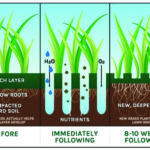
Core Aeration – Pulling Plugs
Core aeration is the mechanical process of removing plugs (cores) of soil from the ground. The plugs are left on the surface of the lawn, where they break down naturally through normal mowing. Aerating is the most effective way to reduce soil compaction. Additionally, regular core aerating will stimulate new root growth, reduce thatch build up and allow more moisture and nutrients to be absorbed into the soil. Aeration is only done during periods of active growth in the spring and fall to promote speedy turf recovery. We generally recommend that established lawns be core aerated in the spring due to better (softer) soil conditions. For newer lawns or thinner lawns that need to be overseeded, fall core aeration is preferred. The core aeration will help prepare the ground for seeding to ensure quick germination and establishment.
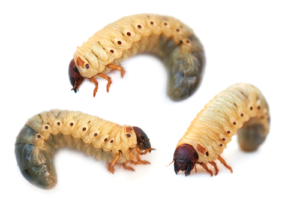
Preventative Grub Control
Grubs are the larvae of the adult beetle. All beetles undergo a 4-stage metamorphosis to complete their life cycle (egg, larvae, pupae, adult). In our area, the Japanese beetle is the primary pest that threatens our lawns and landscapes. In early summer the adults emerge from the ground and feed on the foliage of trees and shrubs in the landscape. While feeding, they mate and the female beetles lay clusters of eggs in the soil. The eggs hatch in the late summer and the larval (grub) stage begins. Damage to lawns occurs during the larval stage as grubs feed at a furious pace on grassroots and other organic matter just below the soil surface. Grub damage can occur quickly and be quite extensive due to the semi-dormant state of turf in the late summer. This is further complicated by the fact that grubs are out of sight, lying just below the surface where the problem can go unnoticed until it is too late. The damage that grubs cause is permanent and repair is costly and time-consuming.
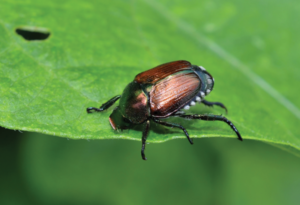
To avoid the likelihood of having grubs damage your lawn, add preventative grub control to your maintenance schedule. This is the most effective way of controlling grubs using safe, proven chemistry. One application in the late spring or early summer offers season-long control. It is applied from May through July (prior to egg hatch) where it is absorbed into the grass plant systemically through the root zone. Once taken in, preventative grub control protects the lawn from root-feeding grubs through the late summer/early fall. Preventative grub control is guaranteed to be effective. We’re so confident, that if your lawn is damaged by grubs after a preventative application, we will apply a curative grub control and repair the damage for free – no questions asked.
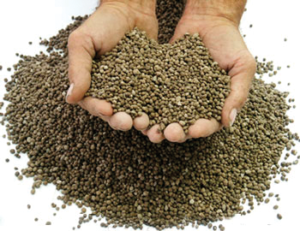
Pelletized Limestone
An application of this natural soil conditioner is essential for adding minerals and maintaining proper soil pH, which makes nutrients more readily available to grass plants. Applications are available in a maintenance rate or a heavy rate, depending on your soil pH. As part of your program, we’ll test the pH of your soil in the early spring and the late fall and will let you know which rate would benefit more. Or you can always bring us a 2-quart sample of your soil, and one of our Lawn and Garden center professionals will test it for you.
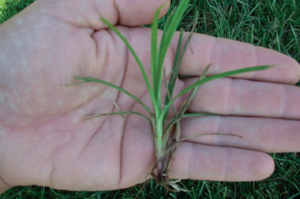
Yellow Nutsedge Control
Yellow nutsedge is an extremely aggressive warm-season perennial weed that dominates some lawns over the summer. Its distinctive light green color and rapid growth habit can really tarnish a beautiful lawn. It reproduces by tubers (bulbs) and spreads by rhizomes (shoots). Applications will selectively control actively growing plants systemically (down to the roots), thus eliminating the reproductive tubers and subsequently reducing potential new plants for next year (and years to come). Eradicating nutsedge is not necessarily the goal, but by addressing each year’s crop earlier in the summer and remaining persistent, nutsedge levels will decrease over time.
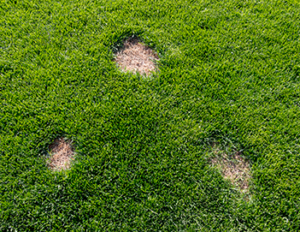
Fungus (Disease) Control
There are disease pathogens present in the thatch layer and soil surface that attack turfgrasses during every season. Most of the turfgrass diseases we encounter can be managed through balanced fertilization and proper cultural practices (mowing, watering, thatch management). However, during severe outbreaks and/or outbreaks of more severe diseases a fungicide application may be warranted. Fungus control applications are made at the curative rate and will offer protection for only 14-21 days.
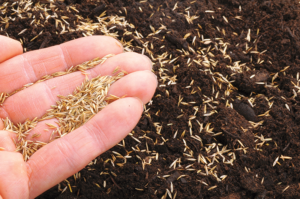
Broadcast Seeding
Broadcast seeding is defined as the scattering of seed over the soil surface through the use of a broadcast or drop spreader. This is a cost-effective way of thickening up thinner lawns where thatch builds up is not a problem and adequate seed to soil contact can be easily achieved. We use only premium cool season seed varieties well adapted to your lawns growing conditions. Application rate is determined by turf density and varies from general (light rate) overseeding to new lawn (heavy rate) overseeding. To ensure adequate loosening of the soil surface for quick establishment of seedlings, broadcast seeding is almost always combined with core aeration (quoted separately). Broadcast seeding is only available in the fall unless special circumstances necessitate spring seeding.
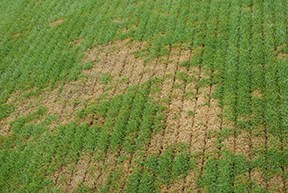
Power (Slit) Seeding
Power seeding is a process that combines the application of seed with a mechanical process that cuts slits or grooves through the thatch layer (less than a ½ inch) to expose the soil for improved seed-to-soil contact. We use only premium cool season seed varieties well adapted to your lawns growing conditions. Application rate is determined by turf density and varies from general (light rate) overseeding to new lawn (heavy rate) overseeding. As with broadcast seeding, combining core aeration with power seeding will greatly improve turfgrass establishment after germination occurs (quoted separately). Power seeding is only available in the fall unless special circumstances necessitate spring seeding.

Lawn Renovation
Some lawns are old and tired and suffer year after year from the same chronic problems. Other lawns may be dominated by undesirable grasses not controllable selectively. And yet others are mostly weeds and crabgrass, containing very little desirable grass. In these cases, it may be better to start over from scratch than to continue to spend time and money on a lost cause. Lawn renovation is the process of killing the existing turf with a non-selective grass and weed control and then reestablishing the lawn from seed through a series of steps that may include dethatching, core aerating and broadcast/ power seeding. Because every lawn is different formulating a plan for lawn renovation varies. We will evaluate the variables involved and present to you a written quote of the recommended steps and their costs to achieve success renovating your lawn. Due to the nature of the work involved, lawn renovations are only scheduled in the fall.
